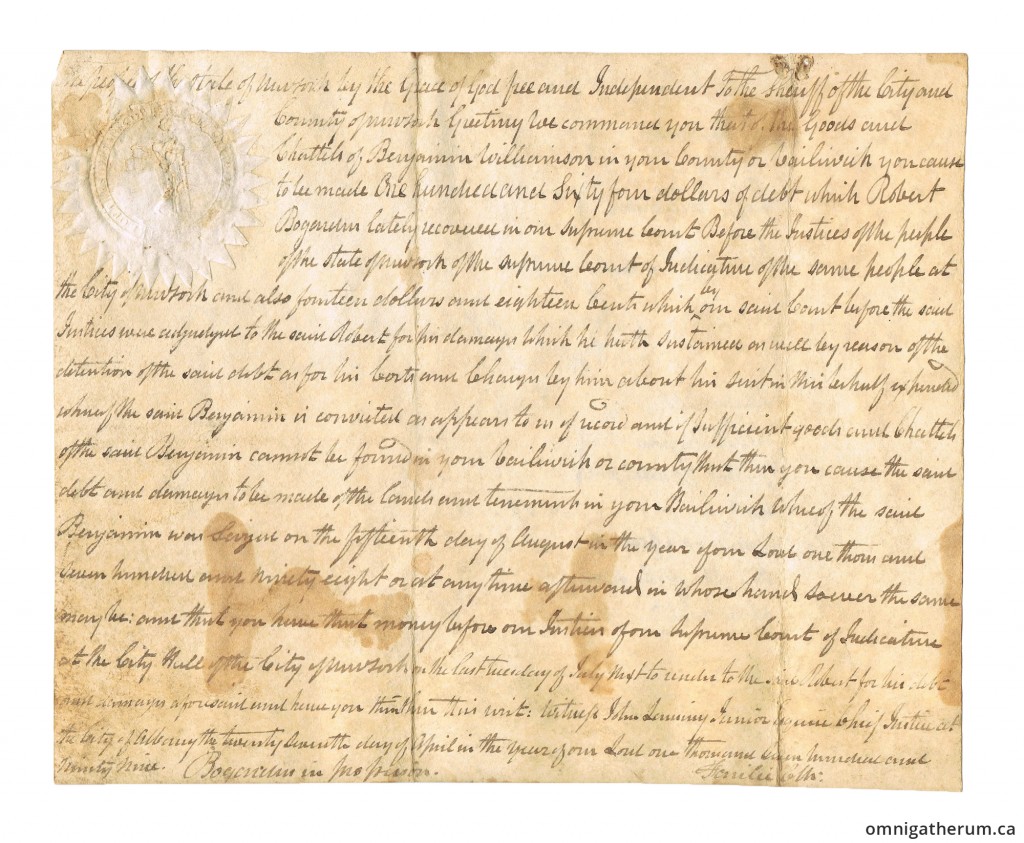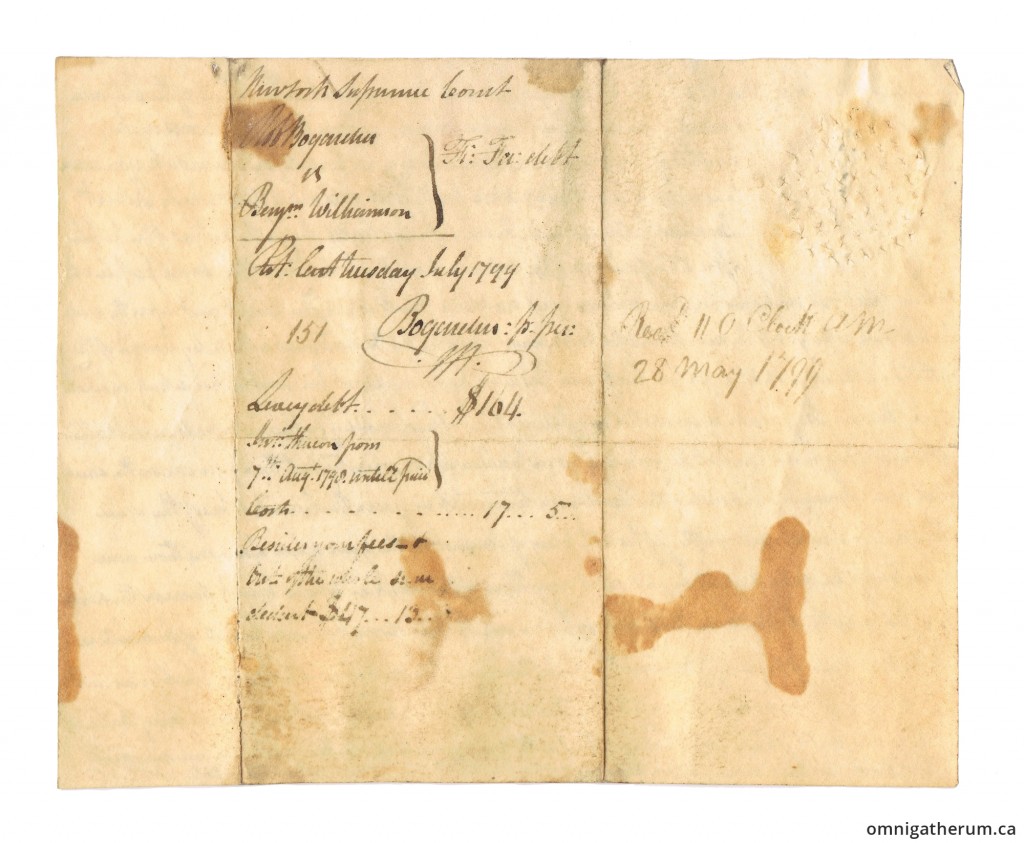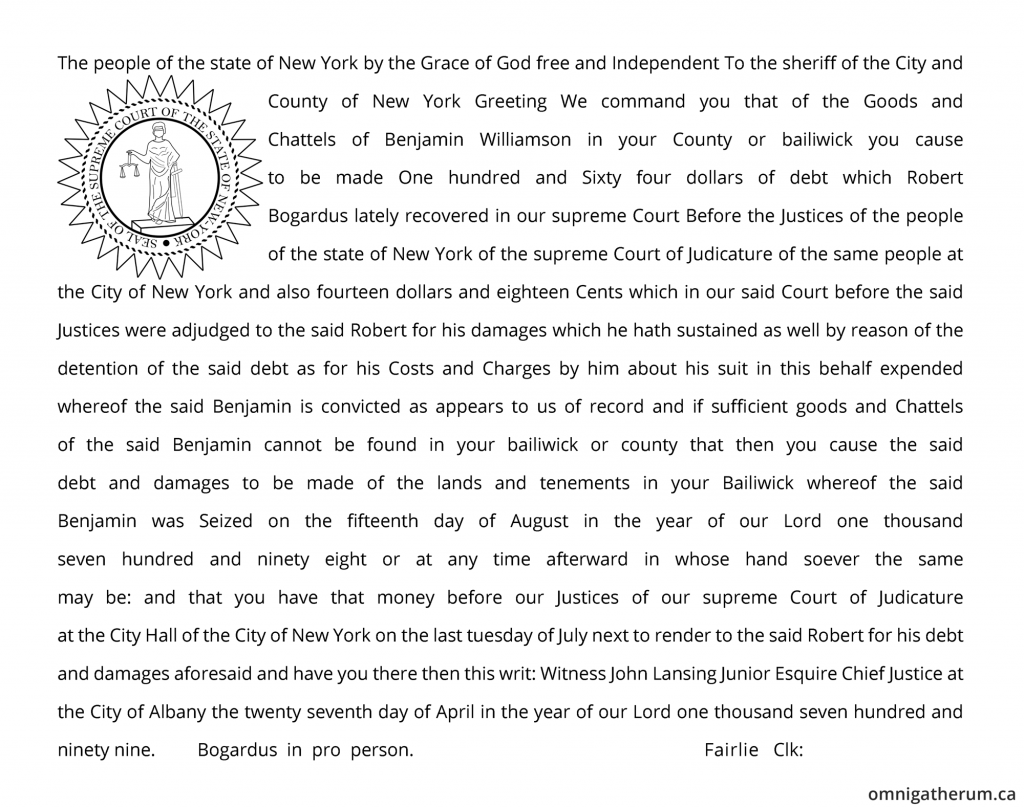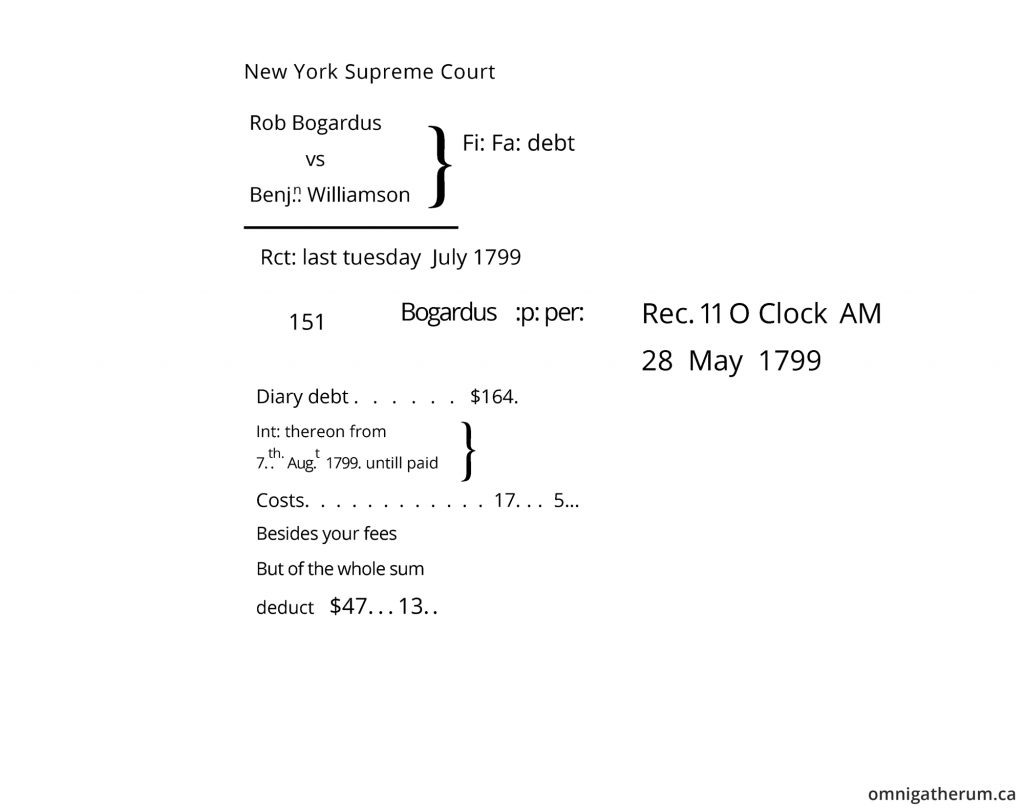Below is an example of a writ of execution, and in particular a capias ad satisfaciendum. Such a writ commands a sheriff to imprison the defendant (in this case, Benjamin Williamson) until the plaintiff (in this case, Robert Bogardus) has recovered his debt (Black, 1910). The writ is on vellum, and measures approximately 18.8cm by 15.5cm. It was issued in 1799 in New York State.
There are four names that appear in this writ: Robert Bogardus, Benjamin Williamson, John Lansing Jr., and James Fairlie. Robert Bogardus (1771 – 1841) was a lawyer and politician from New York (“Robert Bogardus”, 2014). He served in the War of 1812 and, most notably, commanded the 41st Regiment as a colonel, from July 29th 1813 to May 17th 1815 (Heitman, 1890, p. 68). There appears to be a few possible individuals with the name Benjamin Williamson in New York at that time, with none standing out as being the most likely. John Ten Eyck Lansing, Jr. (1754-1829) was a lawyer and politician (“John Lansing, Jr.”, 2015). He was appointed a justice of the New York Supreme Court in 1790, and chief justice in 1798. He disappeared in 1829. James Fairlie (1757-1830) served during the American Revolution as an aide to Baron von Steuben (“James Fairlie”, 2015). He was named a clerk of the New York Supreme Court in 1796 (Bielinski, 2009). Wikipedia has further information about Bogardus and Lansing (along with some sources for further research).
Using MeasuringWorth.com (Williamson, 2015) to calculate the relative value of the amount specified in this writ ($164.00) I came up with a range going from $3,260.00 up to $6,440,000.00, depending on the method used.
In going back to older documents (~50 years prior to the American Revolution) it is interesting to see that the language used in these writs is quite similar. Unsurprisingly, some language used in this writ is still in use (e.g. “goods and chattels”). The “in pro person.” at the bottom of the writ (and on the reverse, as “:p: per:”) is an abbreviation of “in propria persona” which means “for one’s self” (“in propria persona”, 2015). The “clk” after “Fairlie” is an abbreviation of “clerk”. On the reverse, the abbreviation “fi: fa:” stands for “fieri facias” which is defined as a “writ of execution commanding the sheriff to levy and make the amount of a judgment from the goods and chattels of the judgment debtor” (Black, 1910). Something worth pointing out is that clerks (especially earlier in history) would copy text appropriate for a certain situation from a book (such as (Tillinghast, 1830)). Such collections of forms seem to vary (to different degrees) between states and over time. Eventually, clerks would use pre-printed legal forms in which particulars would be the only thing written by hand (an example).
The seal on this writ features Justitia, with scales, sword, and blindfold. Given the damage to the seal on this writ, I used an image of a seal from the Brooker Collection at the Boston College Law Library as a basis for the line drawing in the transcription image below.
I transcribed the document according to the guidelines set out in “Transcripts and Abstracts” in Professional Genealogy (Bell, 2001). According to Bell (p. 293), transcription is (generally) to “copy a document literally, word for word – with all spelling, grammar, and punctuation copied exactly as found.” I’ve done my best to do just that. Given a number of factors, there are a few words that are a bit difficult to make out (and could be incorrect in the transcription). Below the transcription images is a body of text of the front side that has some changes made to capitalization and punctuation.
The people of the state of New York by the Grace of God free and Independent: To the sheriff of the City and County of New York, Greeting: We command you that of the Goods and Chattels of Benjamin Williamson in your County or bailiwick you cause to be made One hundred and Sixty four dollars of debt which Robert Bogardus lately recovered in our Supreme Court Before the Justices of the people of the state of New York of the Supreme Court of Judicature of the same people at the City of New York and also fourteen dollars and eighteen Cents which in our said Court before the said Justices were adjudged to the said Robert for his damages which he hath sustained as well by reason of the detention of the said debt as for his Costs and Charges by him about his suit in this behalf expended whereof the said Benjamin is convicted as appears to us of record and if sufficient goods and Chattels of the said Benjamin cannot be found in your bailiwick or county that then you cause the said debt and damages to be made of the lands and tenements in your Bailiwick whereof the said Benjamin was seized on the fifteenth day of August in the year of our Lord one thousand seven hundred and ninety eight or at any time afterward in whose hand soever the same may be: and that you have that money before our Justices of our Supreme Court of Judicature at the City Hall of the City of New York on the last Tuesday of July next to render to the said Robert for his debt and damages aforesaid and have you there then this writ: Witness, John Lansing, Junior, Esquire, Chief Justice at the City of Albany, the twenty seventh day of April in the year of our Lord one thousand seven hundred and ninety nine.
Acknowledgement
Thank you to the Boston College Law Library for providing a high-resolution image of an identical seal from their collection.
References
Bell, M. M. (2001). Transcripts and abstracts. In E. S. Mills (Ed.), Professional genealogy: A manual for researchers, writers, editors, lecturers, and librarians (pp. 293-327). Baltimore, MD: Genealogical Publishing Company.
Bielinski, S. (2009, February 15). James Fairlie. Retrieved December 29, 2015, from https://www.nysm.nysed.gov/albany/bios/f/jafairlie8015.html
Black, H. C. (1910). Black’s law dictionary (2nd ed.). St. Paul, MN: West Publishing Company.
Heitman, F. B. (1890). Historical Register of the United States Army: From Its Organization, September 29, 1789, to September 29, 1889. Washington, DC: National Tribune.
in propria persona. (2014, April 16). Wiktionary, The Free Dictionary. Retrieved from https://en.wiktionary.org/w/index.php?title=in_propria_persona&oldid=26367919.
James Fairlie. (2015, August 28). Retrieved from https://www.nysoclib.org/collection/ledger/people/fairlie_james
John Lansing, Jr.. (2015, December 16). In Wikipedia, The Free Encyclopedia. Retrieved from https://en.wikipedia.org/w/index.php?title=John_Lansing,_Jr.&oldid=695507818
Robert Bogardus. (2014, March 18). In Wikipedia, The Free Encyclopedia. Retrieved from https://en.wikipedia.org/w/index.php?title=Robert_Bogardus&oldid=600125331
Tillinghast, J. L. (1830). A General Collection of Forms and Precedents, for Process, Entries and Pleadings, in Civil Actions at Law. Albany, NY: William Gould & Company.
Williamson, S. H. (2015, April). Seven Ways to Compute the Relative Value of a U.S. Dollar Amount, 1774 to present. Retrieved from http://www.measuringworth.com/uscompare/result.php?year_source=1799&amount=164&year_result=2015



